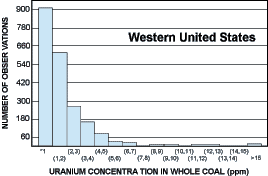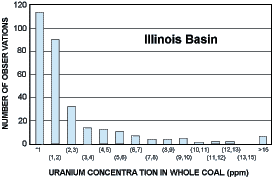
![]()
Fact Sheet FS-163-97
October, 1997
Radioactive Elements in Coal and Fly Ash:
Abundance, Forms, and Environmental Significance
The entire Fact
Sheet FS-163-97 can be downloaded and viewed with Adobe Acrobat
Reader. If you do not already have Acrobat Reader, you may download Adobe
Acrobat Reader from this site.
Introduction
Coal is largely composed
of organic matter, but it is the inorganic matter in coal—minerals and
trace elements— that have been cited as possible causes of health, environmental,
and technological problems associated with the use of coal. Some trace
elements in coal are naturally radioactive. These radioactive elements
include uranium (U), thorium (Th), and their numerous decay products, including
radium (Ra) and radon (Rn). Although these elements are less chemically
toxic than other coal constituents such as arsenic, selenium, or mercury,
questions have been raised concerning possible risk from radiation. In
order to accurately address these questions and to predict the mobility
of radioactive elements during the coal fuel-cycle, it is important to
determine the concentration, distribution, and form of radioactive elements
in coal and fly ash.
Abundance of Radioactive Elements in Coal and Fly Ash
Assessment of the radiation
exposure from coal burning is critically dependent on the concentration
of radioactive elements in coal and in the fly ash that remains after combustion.
Data for uranium and thorium content in coal is available from the U.S.
Geological Survey (USGS), which maintains the largest database of infor-mation
on the chemical composition of U.S. coal. This database is searchable on
the World Wide Web at: http://energy.er.usgs.gov/products/databases/
CoalQual/intro.htm. Figure 1 displays the frequency distribution
of uranium concentration for approximately 2,000 coal samples from the
Western United States and approximately 300 coals from the Illinois Basin.
In the majority of samples, concentrations of uranium fall in the range
from slightly below 1 to 4 parts per million (ppm). Similar uranium concentrations
are found in a variety of common rocks and soils, as indicated in figure
2. Coals with more than 20 ppm uranium are rare in the United States. Thorium
concentrations in coal fall within a similar 1–4 ppm range, compared to
an average crustal abundance of approximately 10 ppm. Coals with more than
20 ppm thorium are extremely rare.
During coal combustion most of the uranium,
thorium, and their decay products are released from the original coal matrix
and are distributed between the gas phase and solid combustion products.


Figure 1. Distribution of uranium
concentration in coal from two areas of the United States.
 The
partitioning between gas and solid is controlled by the volatility and
chemistry of the individual elements. Virtually 100 percent of the radon
gas present in feed coal is transferred to the gas phase and is lost in
stack emissions. In con-trast, less volatile elements such as thorium,
uranium, and the majority of their decay products are almost entirely retained
in the solid combustion wastes. Modern power plants can recover greater
than 99.5 percent of the solid combustion wastes. The average ash yield
of coal burned in the United States is approximately 10 weight percent.
Therefore, the concentration of most radioactive elements in solid combustion
wastes will be approximately 10 times the concentration in the original
coal. Figure 2 illustrates that the uranium concentration of most fly ash
(10 to 30 ppm) is still in the range found in some granitic rocks, phosphate
rocks, and shales. For example, the Chattanooga Shale that occurs in a
large portion of the Southeastern United States contains between 10 and
85 ppm U.
The
partitioning between gas and solid is controlled by the volatility and
chemistry of the individual elements. Virtually 100 percent of the radon
gas present in feed coal is transferred to the gas phase and is lost in
stack emissions. In con-trast, less volatile elements such as thorium,
uranium, and the majority of their decay products are almost entirely retained
in the solid combustion wastes. Modern power plants can recover greater
than 99.5 percent of the solid combustion wastes. The average ash yield
of coal burned in the United States is approximately 10 weight percent.
Therefore, the concentration of most radioactive elements in solid combustion
wastes will be approximately 10 times the concentration in the original
coal. Figure 2 illustrates that the uranium concentration of most fly ash
(10 to 30 ppm) is still in the range found in some granitic rocks, phosphate
rocks, and shales. For example, the Chattanooga Shale that occurs in a
large portion of the Southeastern United States contains between 10 and
85 ppm U.
Forms of Occurrence of Radioactive Elements in Coal and Fly Ash
The USGS has a current
research project to investigate the distribution and modes of occurrence
(chemical form) of trace elements in coal and coal combustion products.
The approach typically involves (1) ultra sensitive chemical or radiometric
analyses of particles separated on the basis of size, density, mineral
or magnetic properties, (2) analysis of chemical extracts that selectively
attack certain components of coal or fly ash, (3) direct observation and
microbeam analysis of very small areas or grains, and (4) radiographic
techniques that identify the location and abundance of radioactive elements.
Most thorium in coal is contained in common
phosphate minerals such as monazite or apatite. In contrast, uranium is
found in both the mineral and organic fractions of coal. Some uranium may
be added slowly over geologic time because organic matter can extract dissolved
uranium from ground water. In fly ash, the uranium is more concentrated
in the finer sized particles. If during coal combustion some uranium is
concentrated on ash surfaces as a condensate, then this surface-bound uranium
is potentially more susceptible to leaching. However, no obvious evidence
of surface enrichment of uranium has been found in the hundreds of fly
ash particles examined by USGS researchers.
 The above observation is based on the use of fission-track
radiography, a sophisticated technique for observing the distribution of
uranium in particles as small as 0.001 centimeter in diameter. Figure 3
includes a photograph of a hollow glassy sphere of fly ash and its corresponding
fission track image. The diameter of this relatively large glassy sphere
is approximately 0.01 cm. The distribution and concentration of uranium
are indicated by fission tracks, which appear as dark linear features in
the radiograph. Additional images produced by USGS researchers from a variety
of fly ash particles confirm the preferential location of uranium within
the glassy component of fly ash particles.
The above observation is based on the use of fission-track
radiography, a sophisticated technique for observing the distribution of
uranium in particles as small as 0.001 centimeter in diameter. Figure 3
includes a photograph of a hollow glassy sphere of fly ash and its corresponding
fission track image. The diameter of this relatively large glassy sphere
is approximately 0.01 cm. The distribution and concentration of uranium
are indicated by fission tracks, which appear as dark linear features in
the radiograph. Additional images produced by USGS researchers from a variety
of fly ash particles confirm the preferential location of uranium within
the glassy component of fly ash particles.

Suggested Reading:
Tadmore, J., 1986, Radioactivity from coal-fired power
plants: A review: Journal of Environmental Radioactivity, v. 4, p. 177–204.
Cothern, C.R., and Smith, J.E., Jr., 1987, Environmental Radon: New York,
Plenum Press, 363 p.
Ionizing radiation exposure of the population of the United States, 1987:
Bethesda, Md., National Council on Radiation Protection and Measurements,
Report 93, 87 p.
Swaine, D.J., 1990, Trace Elements in Coal: London, Butterworths, 278 p.
Swaine, D.J., and Goodarzi, F., 1997, Environmental Aspects of Trace Elements
in Coal: Dordrecht, Kluwer Academic Publishers, 312 p.
| Dr. Robert A. Zielinski, U.S. Geological Survey Denver Federal Center, Mail Stop 973 Denver, Colorado 80225 (303) 236-4719; e-mail: rzielinski@usgs.gov |
Dr. Robert B. Finkelman, U.S. Geological Survey National Center, Mail Stop 956 12201 Sunrise Valley Drive, Reston, VA 20192 703-648-6412; e-mail: rbf@usgs.gov |